Announcing open spots on May 22nd and May 23rd for our Hands On Forcible Entry Class. This class is being hosted by the Platteville Gilcrest Fire District. They have opened half of the spots on each day. This will be the last open class in Northern Colorado for 2015. Check out the flyer for more details.
Archive for the ‘1. Forcible Entry’ category
Halligan By The Numbers
04/23/2015Editor Note: The mechanical advantage of a Halligan has been a recent topic on some training forums. A friend of mine decided to sit down and put on paper what many of us explain when teaching the use of the Halligan. Before you read this I would like to start by saying this is an article for firefighters that like to keep working towards a better understanding of what they are doing and why they are doing it. Does a firefighter need to know the complete break down of mathematics regarding the leverage of the Halligan to force a door correctly? No, not at all. But a firefighter that is instructing others on how to use this tool should have a very solid grasp of how to use the different fulcrums of the tool and should be able to explain where you have more or less leverage depending on how you use it. This article allows you to take a detailed look at what the numbers can look like. This is for those of you that pay attention to the details but still understand the practical application of how this translates to actually using the tool. Understanding leverage and fulcrums is a big part of our job, during the overhaul portion of a fire ground it is very easy to see who has good understanding of tools and their leverage points, hopefully this helps bring a little further understanding to this topic.
Halligan By The Numbers
By Ben Shultz
Let me start off saying that I do not hold a degree in applied mathematics, trigonometry or physics. I do however like putting numbers and statistics to things that I do. It’s simply what works for me and helps to solidify concepts in my mind. So, with that said, here is a short document about the mechanical advantage that we create with the halligan. There are some folks out there that would tell me how I forgot to factor in Pi, a cosign, theta, etc. and therefore my math isn’t perfect. They’d be correct. But, when we keep things simple and look at the halligan as either a class I or II lever, we can still come up with some decent numbers to show the force it can create in different applications.
Quick overview of levers…they are a simple machine. They fall into three classes – I, II, or III. In the case of the halligan, it operates in the class I and II mode. Below you will see an example of a class I lever and how mechanical advantage (MA) is calculated. Example: a seesaw.

Below here you find a class II lever and MA equation. Example: a wheel barrow.
So, you can see in either mode, we need to know the distance from the force (the firefighter) to the fulcrum, and we need to know the distance from the load (the door) to the fulcrum. These numbers allow us to arrive at our MA.
So, here’s what we know about the halligan before we even apply it to a door…
The halligan is 30” in overall length.

The forks are 6” and the crotch is 5”.
The adze is 6” in length.
The adze is 2” wide.
The pick is 6” in length.
The adze/ pick triangle is 5” tall.
With those numbers in mind we have most of what we need to determine how much MA we create in different positions on the door, as you will see below.
Outward Swing Doors (Towards you)
It is often advantageous to gap, crush, tunnel, etc. an outward swinging door to assist in setting the adze. By placing the halligan in such a fashion (disregard hand position and how low on the door the halligan is placed) and moving the bar up and down we are using 30” of the bar from the fulcrum and the door is being impacted by the edge of the adze, which is 2” from the fulcrum. Therefore, we create a 15:1 MA (a lot of force!)
Once the door is gapped, we can either drive the adze in and set it or we can drive the forks in. I’ve heard numerous arguments for and against both methods, and that is a whole topic in itself, so for now I’ll just stick with the MA examples of each.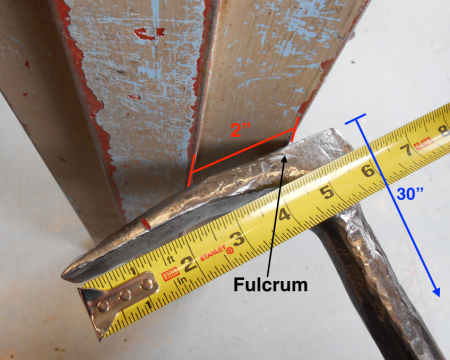
(Door removed for picture purposes)
In this fashion, we see the adze driven to its “mark” that lets us know we’ve driven far enough to clear the jamb and catch the door effectively. This puts 4” of adze past the outside edge of the door frame. That frame edge is our fulcrum. You’ll notice that where the jamb or rabbit is located is at the 2” mark, representing where the inside door edge would be located (the load). This equals 2” of distance from the load to the fulcrum. Once again the distance from the force to the fulcrum is 30”, giving us a 15:1 MA.
Here we have placed the forks for the outward swinging door. Once again, there could be a entire discussion devoted to bevel away or towards a door in forcible entry, but we’re just sticking to MA for now. Note that the fulcrum (outside edge of door frame) is created at about the 3.5” mark. The jamb is located at the 1.5” mark. Once again our load to fulcrum distance is 2”. However, in the forks configuration, we lose a bit of MA, because our force to fulcrum distance is reduced by the length of fork we drive past the fulcrum, in this case that is 3.5”. Therefore we end up with 30” bar minus 3.5” for a force to fulcrum length of 26.5”. So our MA is 26.5 / 2, which equals 13.25:1, still significant, but reduced from the adze application. What’s important to note is that if we had driven the forks to the crotch mark, as is often taught, we reduce our MA to 25/2, or 12.5:1. I know the concept of driving the forks to the crotch is to assure that you have cleared the jamb and have enough fork to grab the door, but it is obvious from this picture that those concerns are addressed with a shallower drive. It’s something to think about.
Inward Swinging Doors (Away from you)
Here we see the set up to initially gap (and possibly force) the inward swinging door. The halligan is used in the same fashion as gapping the outward swinging door, just in a different position. By pushing down on the bar and forks we create a fulcrum on the edge of the 2” wide adze, therefore, the math doesn’t change and we have a 15:1 MA. It’s important to realize that pulling up in this configuration (right side opening door) greatly decreases your MA due to the length of the pick.
Up until now, the halligan has been used in the class I lever mode. Here we find it used in the class II mode. In this set up, we have driven the forks to the crotch mark. This creates our fulcrum at the edge of the door frame at the 3” mark and puts our load at the jamb at the 5” mark, once again, giving us a load to fulcrum length of 2”. Because we have driven our forks 3” past our door frame edge (fulcrum), we have also reduced our force to fulcrum length by 3”, resulting in a D(f) of 27”. Therefore our MA is 27 / 2, or 13.5:1. Once again, I know it is often taught to drive to the crotch, but remember, the deeper we drive the forks, the less MA we have available to us.
I’m sure with the 90 degree bend in a halligan bar and the curve of the forks that there are some really fancy equations to truly figure out the exact MAs for the halligan. So, if you’re not entirely thrilled with the numbers as fact, consider them arbitrary values and simply think of the different configurations as “more” or “less” MA. The key is to have a good grasp on the capabilities of the tool. And don’t forget, in order to achieve the greatest mechanical advantage you have to maximize the force to fulcrum distance, meaning you must pull or push at the end of the halligan. The closer you move to the door, the less MA you realize. With that said, remember that you can increase your force to fulcrum distance, therefore increasing your MA, by introducing a roof hook into the mix or marrying up another halligan at the forks. Finally, like most things in life, there is a trade-off involved. The greater your MA, the shorter your “throw” when forcing a door and vice versa.
(Editor Conclusion)
I first saw this “ballpark mechanical advantage explanation” from Josh Materi while he was explaining Halligan use in a hands on forcible entry drill (video below). Josh does a good job explaining a couple of other ways we commonly use the tool that is not included in the numbers above. What you have to keep in mind is as you force a door and material starts moving, fulcrums change and so does the point of the tool that is prying on the door. This is what makes this rough math and a constantly changing mechanical advantage but you get the picture. Josh breaks down the adze end of the tool into three major categories (the 2″ adze, the 6″ adze and the pike/adze combo) This is the easiest way I have found to keep it simple when instructing which part means what when we put it to work on a door. Thanks a ton to Ben Shultz for writing this article and Josh Materi for permission to use his video clip. -Royal
Security FD Open Enrollment Forcible Entry- Now Open
02/24/2015This class is now open, all registration information is on the flyer. This class will fill very quickly and it looks like we will only have a small amount of additional spots. SecurityFLYER-PDF
Open Enrollment Class in Fort Collins March 21st
02/12/2015This is the first forcible entry class of the season and is being hosted by The Terry Farrell Fund of Colorado. This is their annual training conference held in Fort Collins CO. They put on a good show and are great hosts. This class opened yesterday and I know a large number of the spots have already filled. Please visit their website or use the information on the flyer to register.
Our class will only be held on March 21st and is a full day class. Proceeds will be donated to the Terry Farrell Fund – CO
Visit their website for more information on the entire conference or to register for our class. http://www.terryfund.org/colorado-news/item/195-march-conference
Marriage Invitation: Hook and Halligan
11/29/2014You are cordially invited to make your outside vent tools more user friendly and efficient. The Halligan and 6′ hook has long been the baseline set of tools for the outside vent position. In my fire department the OV position is the “ladders firefighter” (FF sitting behind the driver). This position has a large amount of duties to accomplish when arriving as a first due truck. The driver is the other part of this two person team but we routinely operate by ourselves around the outside of the building performing similar duties. The only time we strictly operate together is during vertical ventilation or during vent enter search. The ladders firefighter will be laddering above grade windows, removing window bars, forcing the c-side door for egress, and performing a horizontal vent when needed.
This gives you a general idea of how that seat works for us and why this position carries a certain tool compliment. When I am riding Ladders I carry a Pig in my belt, with a 6’hook married to a Halligan. The tool in my belt along with the Halligan married to the 6′ hook allows for maximum efficiency because I still have a free hand to bring ladders to the building each time I walk to the truck. I think it is poor practice as an outside vent firefighter to only carry a hook and then have to return to the truck for a Halligan to force the c-side door or remove stubborn window bars. Both which are critical duties that should be accomplished in the first few minutes of our members operating interior.
Here’s the solution for us, and by no means did I invent this. Companies all over the country have been utilizing chain links to marry their hook and Halligan long before I was even in the fire service. I get a lot of questions and emails about this concept and hope I can make a few peoples jobs a little easier.
It’s a simple fix and we have used it on several hooks for many years. By welding a chain link at the appropriate height on the hook it allows you to put the forks of the Halligan over the chain link, then squeeze the tools and slam the base of the hook on the ground. It will cause the forks to bite into the chain link and creates a very tight bond with the tools.
This creates a very easy one hand carry of the tools and reduces hand fatigue. If you currently don’t have these tools married you know that you have to keep a tight grip on them and it is not uncommon for the tools to separate half way to your target. This will be eliminated with the chain link. The bond is tight enough that once you get to your location you very rarely can pull them apart by hand. If I am on concrete or asphalt I will just throw the tools on the ground while I throw my ladder. The impact on the ground will separate them. The other option is to flip them upside down like the photo below and bump the head of the roof hook on hard ground or against the foundation of the house, etc. This will also easily separate them.
There is no set measurement for the chain link that I can give you. This article is obviously on a Pro Bar, but it is going to vary by the brand of Halligan. There are Halligans out there that this will not work with. If you are using a Pro Bar there is some variances on this measurement based on the age of the Pro Bar. I like to make this chain so that all of them will marry up regardless of age.
To get your spacing right, marry up the Halligan with the hook in one hand and slide your chain link in between the forks with the other hand. If the Halligan is pulled down flush to the hook now is the time to give it some space. Your goal is to leave some space between the bottom of the adze where it will touch the top of the hook. The picture below is taken with the Halligan just lightly sitting on the top of the chain. If you leave about a 1/2 inch where that dirty fat finger is, you will end up with enough room to give a nice solid bite on the chain link when you slam the base on the ground.
If you don’t leave enough space the Halligan will bounce off the top of the hook before you ever get a bite. If you are unsure of this, lean towards a little too much space rather than too little. Too much space will still marry the tools together when you bite the chain, even if there is a left over space between the tools. Too little will cause the Halligan to bounce off the hook before it sets properly.
The picture above is after the tool has been slammed on the ground and the Halligan bites the chain. You can see the nice tight fit between the tool heads. Once you find the spacing for your Halligan, make a mark on the chain link and a mark on the roof hook.
Once you have your mark, just use a small tack weld to hold the link to the hook, now put the Halligan back on and just dry fit your mark. Don’t slam the tool down, but see if you like your spacing. If it looks good, run a bead and call it good. I have never had one of these links fail or cause the hook to weaken or bend in any way, shape or form.
Now you have yourself a set of combat ready outside vent tools. I slide mine in the slot at the bottom left of this ladder compartment, they’re married together and pull out very clean and quick. I pull my tools, then select my ladder and I am ready to move within seconds (no extra fumbling around or assembly required!)
Inward Swinging Metal Doors With Drop Bars
10/15/2014Inward swinging commercial metal doors with a variety of different drop bars behind them. Notice on inward swinging doors everything is mounted to the frame causing it to be blind from the outside. Gap Set Force.
Skinning Metal Doors and Obtaining a Gap
10/09/2014This video shows a very important skill that is very difficult to describe and teach without having real metal doors. At the same time I truly believe it is one of the most important skills a firefighter needs to know during outward swinging door forcible entry. If the door skins too bad without being overcome, it can prevent you from getting in a very simple door. If you are not familiar with skinning doors, please take the time to watch this one out of all of the other videos.
Kicking Doors 101
04/13/2014A quick thought on kicking doors. We teach not to do it. Not because it won’t open doors, because honestly it will open a lot of them. I am not trying to kid anyone and say that we have not kicked open residential doors before. But I will say when I was still kicking doors open it is because I didn’t properly understand how to use a Halligan bar. So kicking was the easiest way for me to open an apartment door that was on fire. After I gained some experience, learned my way around a set of Irons and really thought about when and when not to kick a door, it became real clear to me that because I was now properly trained on a Halligan bar (and I carry it), there was no reason for me to kick doors open. They can be opened just as fast with a competent person on the tool. The other thing I noticed was kicking doors was wasted experience, it was a perfect opportunity to hone your skills with the Irons on a real door in a real frame. Thus building your confidence and not letting all of your experience be based on a forcible entry prop. Lastly, when luck runs out, because at some point it will, a person who is competent on their Irons now has multiple options and is very proficient in them because they have been forcing doors with the Irons for most of their career instead of kicking them for 15 years. Attacking doors based on knowledge rather then luck will give you a much stronger foundation when it’s time to force the doors that are out of the ordinary. You will find doors you cannot kick, and when you do, and the luck of kicking runs out, you will set the tone for the fire ground with a real bad forcible entry situation. To many people are relying on us to base our operations on luck. Long live skillful Irons work!
These doors are all out of occupied residential homes.
Hand On Forcible Entry Class – Video Preview
02/15/2014Here is a video preview for our hands on forcible entry classes. Thank you for all the support over the years, we have officially trained over 1000 Colorado Firefighters. We still have plenty more to go! Sign up today, or contact us about being a host department. Lets keep spreading the solid forcible entry technique based on a foundation of good Irons work.
Please share this video if you have taken our class and thought it was worth your time and money.



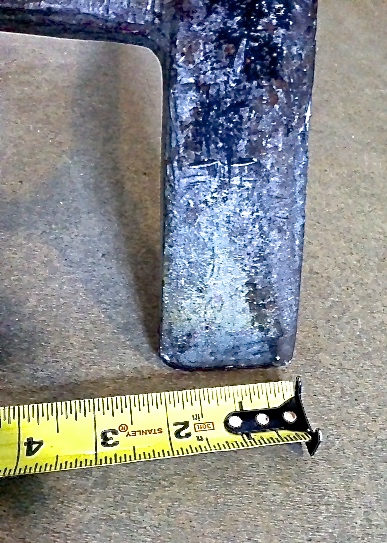


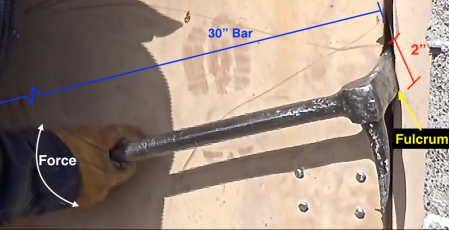


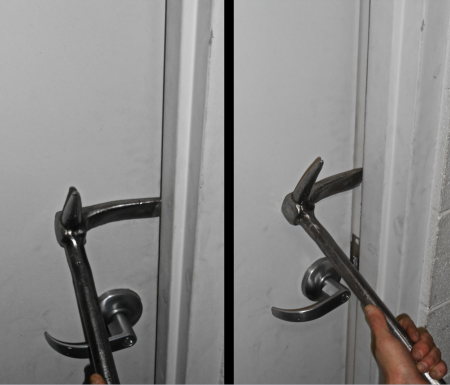
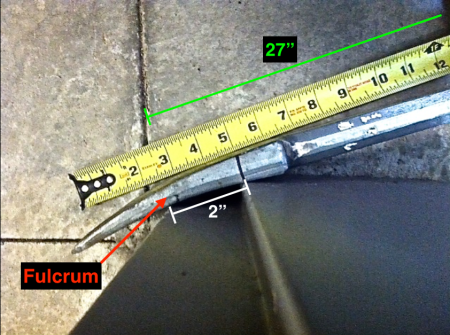


















Recent Comments